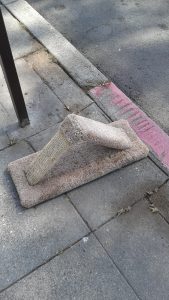
Often when I’m walking around (I don’t have a car, so I do that a lot), I see a tiny, unused “cat scratcher,” which has generously been placed out on the sidewalk in case someone else wants to make the mistake of thinking their cat will use it. I usually think to myself “awww, the human tried, but they bought the cheapest cat scratcher, and have now (in their mind) reaffirmed the idea that cats won’t use cat scratchers.” If only the human had done a little research, and invested a little more money, they would have had a better chance of getting their cat to use the scratcher instead of the sofa.
So WHAT kind of scratcher do cats like? The short answer is, it depends. But a new study has tried to get a little more info (based on owner report) as to what cats like to scratch. Owner observations regarding cat scratching behavior: An internet-based survey, recently published in the Journal of Feline Medicine and Surgery, asked over 4000 people to tell them about their cat’s scratching habits and preferences. The results suggest that there might be a mismatch between what cats are offered to scratch, and what they like to scratch.
First of all, the good news was that most cats in the study (83%) were given more than one thing to scratch (besides the sofa). I do wonder if there is a self-selecting bias in the survey, as the authors said they excluded those who had no scratching post in the home, and in my consulting work, I’ve definitely run into plenty of households with no scratchers. Most owners offered scratchers that were made of carpet, with rope not far behind. Owners reported that their cats used rope scratchers more frequently than other types, particularly if their cat was nine years or younger.
Despite having scratching options, about half of owners (52%) reported that their cat still scratched something that was inappropriate to the owner, even when there was something “appropriate” nearby. This did not depend on whether the cat had outdoor access, although in general, cats who were allowed outside used their scratchers less frequently. It’s not clear from the report as to whether cats who scratched inappropriately (note: I am using this term to describe the owner’s perspective, scratching is completely natural and appropriate for cats) were offered multiple substrates to scratch or not.
Inappropriate scratching seemed to increase when scratching surfaces were hung and when scratching posts were shorter than three feet tall. There was less inappropriate scratching reported when cats had sisal rope options, and when there were cat trees with multiple levels available.
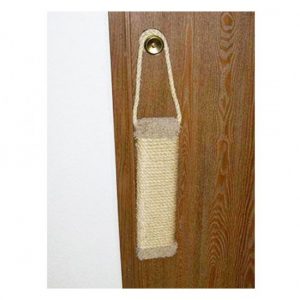
Hanging scratchers ensure low compliance!
Rewarding cats for using their scratching posts increased use, while punishment had no effect on frequency of use of desired scratching options. Owners of cats obtained from a breeder reported less inappropriate scratching; the authors attributed this to the breeding environment, but it is possible that owners who spend a lot of money on purebred cats also spend more money on cat trees and better (or more) scratchers!
The nice thing about this study is that is supports what many of us cat behavior consultants have been advising clients for years. Reading between the lines, we can see that while most cats prefer sisal rope, cats have individual preferences. To increase the likelihood of your cat scratching something appropriate to YOU, you should:
- Offer your cat multiple things to scratch (different options for substrates, such as rope, wood, carpet, cardboard)
- Make sure those scratching options are tall and sturdy
- Reward your cat with praise and treats when they scratch the desired object
- Stop buying crappy scratching products! (I recommend the Mondo, or the Ultimate Scratching Post)
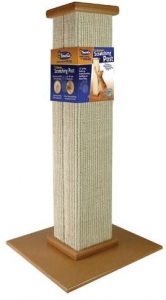
Another recent study, reported at a conference (but not yet peer reviewed or published) looked at kitten behavior in regards to scratching. His finding was that kittens preferred scratchers that had other cats’ scent on it (deposited via cat hair), in comparison to catnip (although it should be noted that young kittens do not often respond to catnip, so I’m not sure how effective a comparison that is). The lab is looking at different pheromones to see what might have the biggest attracting effect on kittens. It brings up many other questions: are substrate preferences for scratching in adult cats formed in kittenhood? Do kittens and adult cats have the same needs and preferences? So much more science to be done!
There have been previous studies on a pheromone product called Feliscratch, that suggested cats will scratch posts more frequently and for longer durations when Feliscratch is added.
So why isn’t this stuff in every pet store? From what I’ve heard, Feliscratch smells “cheesy” and unappealing to Americans (yes, we are weird), so the product has not yet been introduced in the US (although it is available in Europe). Perhaps someone can smuggle some over for us Yanks and our cats.
References:
Cozzi, A., Lecuelle, C. L., Monneret, P., Articlaux, F., Bougrat, L., Mengoli, M., & Pageat, P. (2013). The induction of scratching behaviour in cats: efficacy of synthetic feline interdigital semiochemical. Journal of feline medicine and surgery, 1098612X13479114.
Wilson, C., Bain, M., DePorter, T., Beck, A., Grassi, V., & Landsberg, G. (2015). Owner observations regarding cat scratching behavior: an internet-based survey. Journal of feline medicine and surgery, 1098612X15594414.

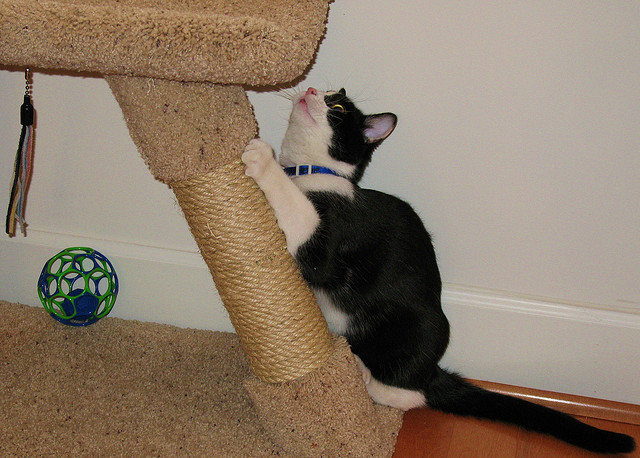
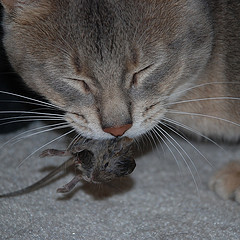

Loved the article – nice confirmation of a lot of things I was taught and some new tricks to try out – for instance, feliscratch. I wasn’t aware that this was something that was available here in Europe <3